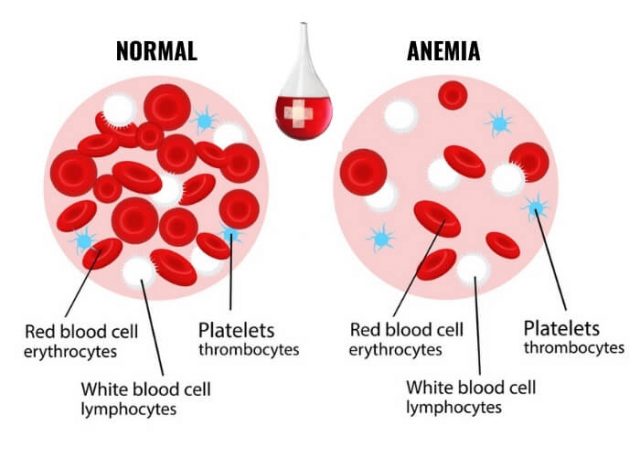Learn about blood, its functions and disorders, and how Lupus affects blood and the lymphatic system.
Lupus, an autoimmune condition, can affect various parts of the body including blood. Blood disorders may be associated with lupus due to lupus, its treatment or other comorbidities. Before delving further, let’s first understand what blood is, its composition and functions.
The four main components of blood are red blood cells, white blood cells, platelets and plasma. In humans, all red blood cells, platelets and most white blood cells are produced in the bone marrow (the soft fatty substance housed in the cavities of bones).


Red blood cells, which are bright red in color from hemoglobin (protein) and shaped like biconcave discs, make up 40-45% of the total blood volume. Red blood cells carry oxygen from the lungs to parts of the body, and return carbon dioxide from the body back to the lungs for exhalation. Synthesizing hemoglobin requires iron, vitamin B12 and folate (vitamin B9).
White blood cells protect the body against infection and are much fewer in number than red blood cells. The different types of white blood cells are granulocytes (neutrophils, basophils and eosinophils), lymphocytes (T cells and B cells), and monocytes.
Platelets, called thrombocytes, are fragments of cells that help blood clot to prevent blood from leaking at wound sites. They also stick to the linings of injured blood vessels.
Plasma, the liquid component of the blood, consists of water, sugar, fat, proteins and salts. Plasma helps in transporting blood cells throughout the body.
Disorders of blood with Lupus


- Anemia (reduced red blood cell count)
Anemia is a condition associated with significantly lower red blood cells. If the body does not get enough oxygen, it can cause fatigue, weakness, shortness of breath and an irregular heartbeat. Anemia is a common disorder affecting more than 50% of people with lupus. Inflammation, medication, iron deficiency from blood loss, and kidney involvement may all contribute to the development of anemia with Lupus.
Lupus medications, Cyclophosphamide, Mycophenolate and Hydroxychloroquine, are associated with bone marrow suppression. They can cause a decrease in red blood cells.
Nonsteroidal anti-inflammatory medications (NSAIDs) can cause digestive tract bleeding, resulting in iron deficiency anemia from blood loss.
- Leukopenia (reduced white blood cell count)
A decrease in white blood cells can occur especially when the disease is active. Most of the white blood cells in our body are neutrophils. A decrease in the number of neutrophils, called neutropenia, may be accompanied by infection. Causes include immunosuppressive medications and viral infections. Lymphocytopenia, a decrease in the number of lymphocytes, may also occur.
It is rare for white blood cells to be low enough to cause infection. The immunosuppressive agents – Cyclophosphamide, Azathioprine, 6-Mercaptopurine and Glucocorticoids (Prednisone, Prednisolone, Methylprednisolone), cause bone marrow suppression and an eventual decrease in white blood cells
- Thrombocytopenia (reduced platelet count)
Antibodies against platelets are the major cause of the reduced quantity of platelets with lupus. Other causes are immunosuppressive agents that suppress bone marrow. A low number of platelets can lead to petechiae or bleeding. Although thrombocytopenia is common in lupus, it rarely causes serious bleeding.
- Pancytopenia (reduced number of red blood cells, white blood cells and platelets)
A reduction in all three components of blood is less common in lupus. There are many potential causes of pancytopenia, including bone marrow toxicity caused by medications and infections.
- Leukocytosis (increased number of white blood cells)
An infection or high dose of steroids are the usual causes of increased white blood cells with lupus. A flare or infection increases the number of neutrophils. An increase in the number of lymphocytes can be due to swollen lymph nodes or cancer.
- Thrombocytosis (increased number of platelets)
An increase in the platelet count may occur from blood loss due to gastrointestinal bleeding, iron deficiency, infection or inflammation with Lupus.
Swollen lymph nodes


The lymphatic system, which plays a key role in the immune system, is a network of organs (tonsils, spleen and thymus glands), lymph nodes and vessels. Lymph nodes, also called lymph glands, are bean-shaped structures throughout the body that contain immune cells (white blood cells). Clusters of lymph nodes are found in the neck, underarm, groin, chest and abdomen.
Swollen lymph nodes occur most commonly as result of infection or cancer. Lymph node enlargement occurs in approximately 50% of people with Lupus.
Disorders that affect blood are periodically checked by your doctor. It is important to keep all your doctor appointments. If you experience a reduction or increase in any blood cell types, your doctor may conduct tests to determine cause and manage the blood disorder.


